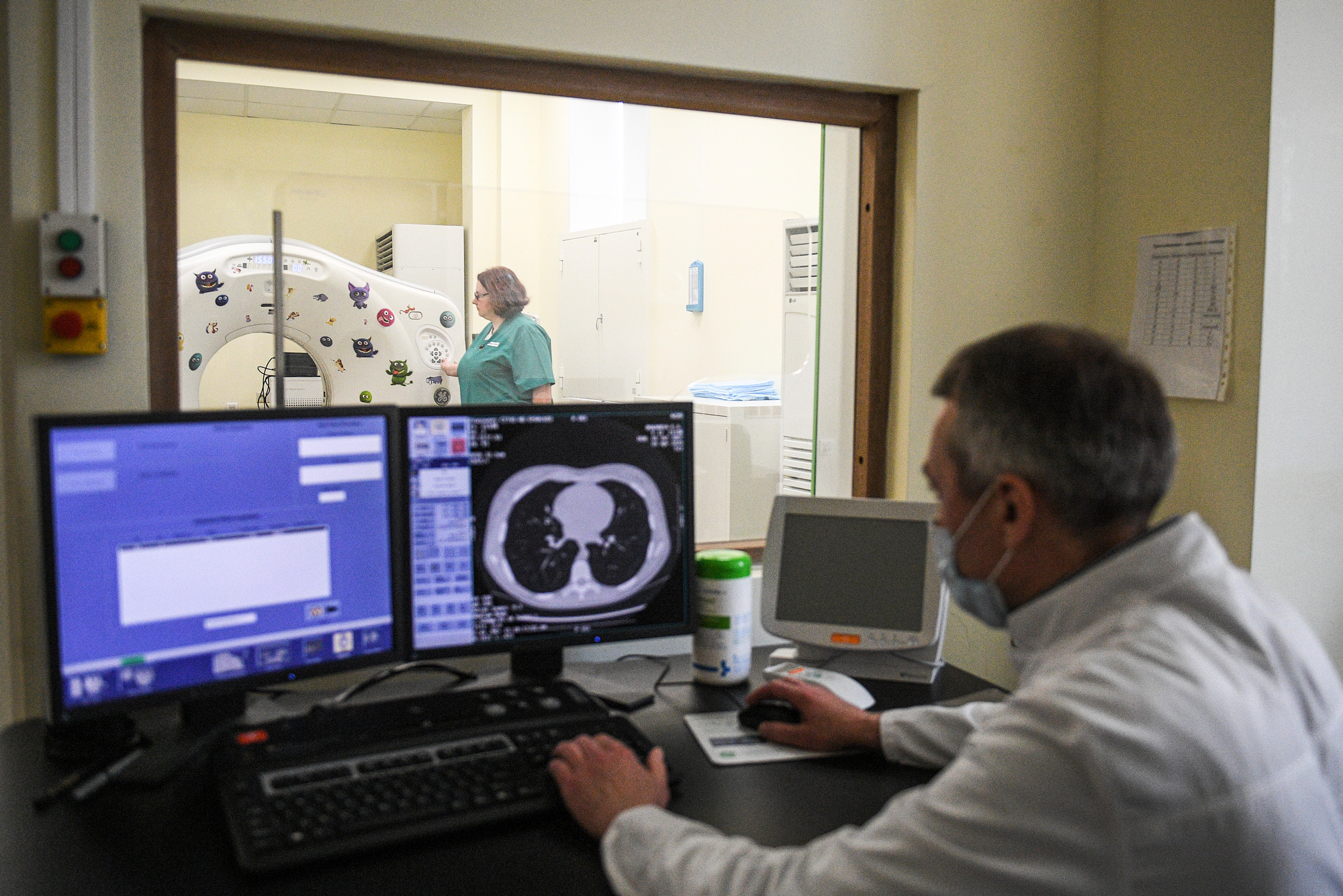Locked-in Syndrome and the Misplaced Presumption of Misery
In 1993, Julio Lopes was sipping a coffee at a bar when he had a stroke. He fell into a coma, and two months later, when he regained consciousness, his body was fully paralyzed.
Doctors said the young man’s future was bleak: Save for his eyes, he would never be able to move again. Lopes would have to live with locked-in syndrome, a rare condition characterized by near-total paralysis of the body and a totally lucid mind. LIS is predominantly caused by strokes in specific brain regions; it can also be caused by traumatic brain injury, tumors, and progressive diseases like amyotrophic lateral sclerosis, or ALS.
Yet almost 30 years later, Lopes now lives in a small Paris apartment near the Seine. He goes to the theater, watches movies at the cinema, and roams the local park in his wheelchair, accompanied by a caregiver. A small piece of black, red, and green fabric with the word “Portugal” dangles from his wheelchair. On a warm afternoon this past June, his birth country was slated to play against Spain in a soccer match, and he was excited.
In an interview at his home, Lopes communicated through the use of a specialized computer camera that tracks a sensor on the lens of his glasses. He made slight movements with his head, selecting letters on a virtual keyboard that appeared on the computer’s screen. “Even if it’s hard at the beginning, you acquire a kind of philosophy of life,” he said in French. People in his condition may enjoy things others find insignificant, he suggested, and they often develop a capacity to see the bigger picture. That’s not to say daily living is always easy, Lopes added, but overall, he’s happier than he ever thought was possible in his situation.
While research into LIS patients’ quality of life is limited, the data that has been gathered paints a picture that is often at odds with popular presumptions. To be sure, wellbeing evaluations conducted to date do suggest that up to a third of LIS patients report being severely unhappy. For them, loss of mobility and speech make life truly miserable — and family members and caregivers, as well as the broader public, tend to identify with this perspective. And yet, the majority of LIS patients, the data suggest, are much more like Lopes: They report being relatively happy and that they want very much to live. Indeed, in surveys of wellbeing, most people with LIS score as high as those without it, suggesting that many people underestimate locked-in patients’ quality of life while overestimating their rates of depression. And this mismatch has implications for clinical care, say brain scientists who study wellbeing in LIS patients.
Eleven U.S. states and several European countries, for example, have legalized various forms of assisted dying, also known as physician-assisted suicide or medical aid in dying. In these places, families and clinicians are often involved in fraught decisions about whether to actively end a person’s life or pursue life-extending interventions such as mechanical ventilation. Advocates for the right to die, a movement that dates back to the 1970s, have historically raised concerns about the potentially dehumanizing nature of these interventions, which can lengthen a person’s life without improving its quality. They specifically argue that LIS patients should be able to decide whether to end their lives or stop life-extending treatment.
Brain scientists do not disagree, but they worry that inaccurate and negatively-skewed ideas about what it means to live with LIS could unduly tip the scales. “It’s important to not project our thoughts and feelings” onto others, said Steven Laureys, a neurologist and research director of the Belgian National Fund for Scientific Research. While non-disabled individuals might say, “‘this is not a life worth living,’” he added, the evidence doesn’t necessarily bear this out.
He and his colleagues want to ensure that their research is shared with LIS patients, their families, and physicians. The researchers are also trying to better understand which factors contribute to a patient’s overall sense of satisfaction.

Because LIS syndrome is rare, surveys of patients tend to be small, making it difficult to draw firm conclusions. Still, the vast majority of studies point in the same direction: A majority of locked-in patients are relatively happy. One early study, published in 2002, found that of 44 LIS patients, almost half reported their mood as good while 13 percent reported feeling depressed. A later study, published by Laureys and his colleagues in 2011, found that of 65 patients, just over two-thirds considered themselves happy while less than one-third said they were unhappy. Seven percent of all patients expressed a wish for assisted dying.
Laureys’ findings should be interpreted with some caution, said Fernando Vidal, a historian and medical anthropologist at the University of Rovira i Virgili in Spain, who was not involved in the study. Almost half of the patients the scientists first reached out to did not respond to the survey, he pointed out — meaning the researchers may have inadvertently selected a sub-group of happy patients. He added that wellbeing surveys in general tend to overlook important nuances about how LIS patients experience life, including their moods, values, and social relationships.
Still, similar results were found for people at advanced stages of ALS. In one study of 93 patients, the majority had a positive attitude toward life-sustaining treatments and had a low desire for hastening death.
Researchers are currently trying to learn if these findings extend to patients with even more extreme physical impairments. In late stages of ALS, some patients become totally paralyzed, including their eyes — a condition known as completely locked-in syndrome. In March, Nature Communications published the results of a widely-discussed study in which a completely locked-in patient was able to communicate at length for the first time by using a brain-computer interface.
Brain-computer interfaces are controversial, raising safety and bioethical concerns. And Niels Birbaumer, the neuroscientist who led the March study, has previously been accused of scientific misconduct, along with his research associate, Ujwal Chaudhary. In 2019, the German Research Foundation found evidence of mishandled data and flawed analysis in two of their papers testing brain-computer interfaces in LIS patients. Both papers were subsequently retracted, and the researchers were asked to repay their grant funding. The researchers continue to defend their past work, and more than 70 scientists have expressed their support on a website devoted to their defense.
A representative from Nature Communications has voiced confidence in the journal’s vetting of the March paper. In this latest study, the patient expressed wanting to listen to his favorite music, eat curry, and watch movies with his child. These are clear signs that the study participant is motivated, interested, and still able to enjoy his life, said Birbaumer.
Birbaumer also shared a video with Undark of the patient answering yes-no questions to a wellbeing survey. In the video, he expresses appreciating his life, rarely being sad or depressed, and living with a sense of meaning. (To protect the study participant’s privacy, the video is unpublished.) “He had excellent quality of life,” Birbaumer wrote in an email. But only a few patients who are completely locked in have received brain-computer interfaces, added Birbaumer, so it’s impossible to draw firm conclusions about the entire population’s wellbeing.
It’s also not clear how well these patients will do over time. In the three years since the implants were placed in the study participant’s brain, his communication has become slower and less clear — an outcome that his current physician suspects is due to technological issues.
Despite the accumulating evidence that happiness and fulfillment are possible for locked-in people, notions about what is necessary for a good life have been slow to change, even among patients’ family members and caregivers.
One study led by Dorothée Lulé, a professor of experimental neurology at the University of Ulm, Germany, recruited 89 ALS patients, 86 caregivers, and 102 healthy individuals. (Like other researchers, the authors use the term “healthy” to refer to people not living with ALS.) The patients were asked to rate their own quality of life, the caregivers were asked to rate the quality of life of the patient under their care, and the healthy people were asked to rate the quality of life of a virtual patient.
As a group, the patients reported a satisfactory sense of wellbeing with a low wish to hasten their own deaths. The caregivers and healthy people, on the other hand, overestimated how depressed ALS patients were and underestimated ALS patients’ quality of life.
In a separate study of more than 3,000 healthy people, more than half said they would not want to be kept alive with locked-in syndrome.
Marie-Christine Nizzi, a research associate in cognitive science at Dartmouth College, characterized the dominant perspective as “an able-bodied biased view by which it seems that such a life is unbearable and must be awful.”




















